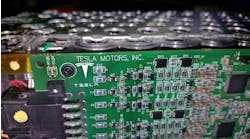Content brought to you by Auto Body Repair Network. To subscribe, click here.
What you'll learn:
- Why UV products are once again popular
- How it may benefit your paint shop
- How equipment selection and application differ from traditional primer surfacers
- Unique characteristics of UV primers
Although UV products have been used in the automotive industry since the early 2000s, their popularity seems to come in waves.
Initially, not only were these products new, unproven technology, but a major hang-up for the end user was the need for a new UV light to cure the product. For decades prior, shops had become more adept at using IR curing lights to shorten dry times and increase throughput. Now this new product required additional cost to cure it, along with safety precautions because of exposure to UV light.
Fast forward to today, and enough time has passed that UV has found its place in our business. There are more UV curing light options than ever before. There’s also a wide variety of UV products in the market from all kinds of manufacturers. Those products range from primer surfacers to clear coats to spot putties. In this article, I will primarily focus on UV primers, since they are the most relevant product in our business. I also prefer to focus on products designed by what we’ve come to address as “premium paint manufacturers.” These products have good technical information available and often have a full paint system warranty associated with them.
UV primer characteristics
• I like to group UV products into two categories. The first uses true UV-cure technology, which requires a UV light with a specific spectrum of UV light to cure. These products are most commonly found in ready-to-spray (RTS) form, and they typically require only a quick shake or stir before pouring into your gun’s cup. The second can be referred to as “dark-cure” UV products. Dark-cure UV products are also cured with a UV light for maximum speed, but in time, areas where the light does not hit will still cure. Those products often require a catalyst (hardener) to be added prior to spraying them.
• Most UV products are semi-transparent. Because they are cured with light, the product must have a decent amount of transparency to allow the light to travel to the bottom of the film.
• UV products still have solvent that will need to evaporate out of the film during flash times and the curing cycle.
• Due to the footprint on the UV curing light, UV products are typically focused on small, spot-priming repairs. Usually, the maximum size repair is around a 12”x24” area. Larger footprint portable lights are available as well, all the way up to UV-cure spray booths.
How equipment differs from traditional primer surfacers
The application process for UV primers is not too far from what we would consider standard; however, I strongly suggest reading your paint supplier’s technical data sheet. This is to ensure you’re using the proper spray gun setup to achieve targeted film builds as well as flash times and proper cure times.
Spray guns designed for spraying UV primers feature a spray gun nozzle set that finely atomizes the product to ensure an even film build. The superior material distribution throughout the pattern avoids thickness variations that can cause dark spots and lead to uncured product. As I mentioned previously, these products are slightly pigmented and will show a blotchy appearance if sprayed improperly or with inconsistent film build.
And since UV products are photochemically reactive, which means they begin to cure as soon as they are exposed to natural daylight, it is important to use an opaque spray gun cup.
Using a black cup for spraying UV products ensures the product has not been exposed to light that could potentially alter the characteristics of the product and its performance. With the spray gun cup preventing light exposure, you can now pour UV primer in the cup, mount it to a gun, and spray all day. The product will have a much longer pot life than traditional primers, allowing for no wasted material going into the waste drum.
Additionally, a black rubber air cap cover keeps light from hitting that little bit of product left on the tip of the needle. Using one of these caps between coats and while the spray gun is hanging between repairs ensures product and spray gun performance. That little drip on the needle can harden in daylight and end up being dirt in the repair you’re priming.
Check out the video below to see SATA/Dan-Am Co.'s Tony Larimer demonstrating this process.




